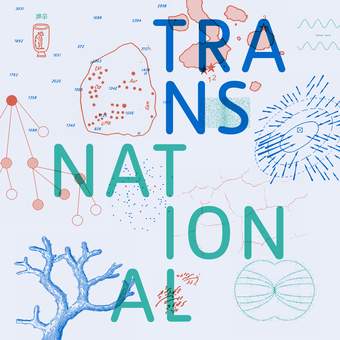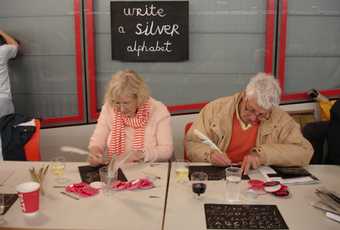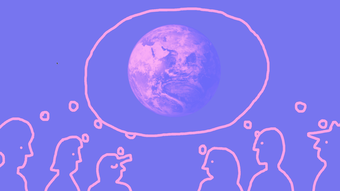In an era of globalisation art engages with politics and social issues in ways that cross international borders.
But how do artists approach this?
Concern for our human and environmental rights might be shared but this film introduces five artists working locally and globally to address mutual struggle in their communities and beyond.
For artist Outi Pieski, a belief in collective ancestry is one way to bridge distances.
Outi is part of the Sámi people who live in Sápmi, an area including parts of Norway Sweden, Russia and Finland.
For her piece Guržot ja guovssat / Spell on you!, Pieski worked with other Sámi women from all over the region.
They came together to practice duodji, a set of crafts passed down between generations.
Duodji is deeply spiritual, allowing makers to draw energy from materials like wood and textiles.
The makers discuss the past, present and future offering a chance to heal from trauma caused by colonialism.
Outi says, "Duodji is radical softness dealing with vulnerability sincerity, sensibility and communality. It highlights that we are living in a reciprocal relationship with all living entities."
This sense of kinship with non-human beings can also be seen in Outi’s paintings where forest, rivers and mountains appear powerful, communicating with the viewer.
Carolina Caycedo also seeks to honour the natural world. Her work Land of Friends focuses on a river in Colombia known by locals as Yuma but named Magdalena by Spanish colonists.
Privately owned satellite imagery shows the environmental damage caused by dam building.
But what about the people who live here?
The corporations that build infrastructure to control the river’s flow not only create ecological problems but re-enact colonial oppression towards Indigenous lives.
By documenting what she calls the river’s geo-choreographies or the everyday gestures that sustain its importance, Caycedo demonstrates solidarity with an interdependent rural way of life that flows with nature.
This attitude preserves both the river itself and those who rely on it.
But solidarity might not only be shared via a real life community.
In Anna Daučíková’s Expedition for Four Hands and Accompaniment the artist creates a conversation with Zak Kostopolous.
The activist and drag performer known as Zackie Oh was murdered in Athens in 2018.
Via a three channel film installation and newspape report created in collaboration with Kostapolous’s friend we see how an act of mourning can also become one of solidarity.
In the darkness of a cave two sets of hands perform rituals. The artist’s hands cut glass whilst another carefully folds garments.
Are they Kostopolous’s?
Daučíková identifies as transgender and has been an active advocate for LGBTQ rights in their home country of Slovakia.
Although the two never met, by connecting their physical body with Kostopolous’s memory, Daučíková draws parallels in experience across space and time.
What is it like to exist in society outside of gender binaries?
Who decides what is acceptable and what are the consequences?
Zanele Muholi also deals with the visibility of queer experience.
Describing themselves as a visual activist we sense the continuing threat of violence posed to queer, trans and intersex communities despite the lifting of apartheid.
In the series Only Half the Picture we see a bandage that suggests a recent wound.
Other photos feature tender embraces or an unflinching gaze directed at the viewer.
What matters the most is the content: who is in the picture... and why are they there?
Documentation becomes an act of resistance.
By sharing these images with a global community they attempt to address injustices and highlight who receives care within society.
Archives are also important to artist Rita Keegan.
Starting with her collection of family photos, Keegan began to think about how artists of colour could preserve memories together.
What was being erased or left out of art history?
My assumption was that everybody had these family photographs. Little did I know that I was incredibly lucky. I also felt it was important to represent people of colour not just working in the fields because we did lots of other things... and we dressed up.
Born in the Bronx but later basing herself in the UK she co-founded Brixton Art Gallery and the Women Artists of Colour Index.
Her own ever-expanding archive is a cross-cultural account of Black dress adornment and rituals.
Materials including textiles, writing and photography celebrate the fabric of domestic life by emphasising the richness in the everyday.
Rita challenges what has historically been undervalued within the Western male art canon.
These artists show us the power of collaboration across borders and the possibility art has to raise awareness of different issues around the globe.
Does art replace the legislative powers of government or corporations?
Maybe not entirely but redirecting our energy towards communally minded approaches can help us see injustice and show us the way towards change.
How do artists create work within their communities, in a way that helps us see injustice and shows us the way towards change?
In this film we look at five artists who demonstrate the power of collaboration across borders: Outi Pieski, Carolina Caycedo, Anna Daučíková, Zanele Muholi and Rita Keegan.
Research supported by Hyundai Tate Research Centre: Transnational in partnership with Hyundai Motor.



